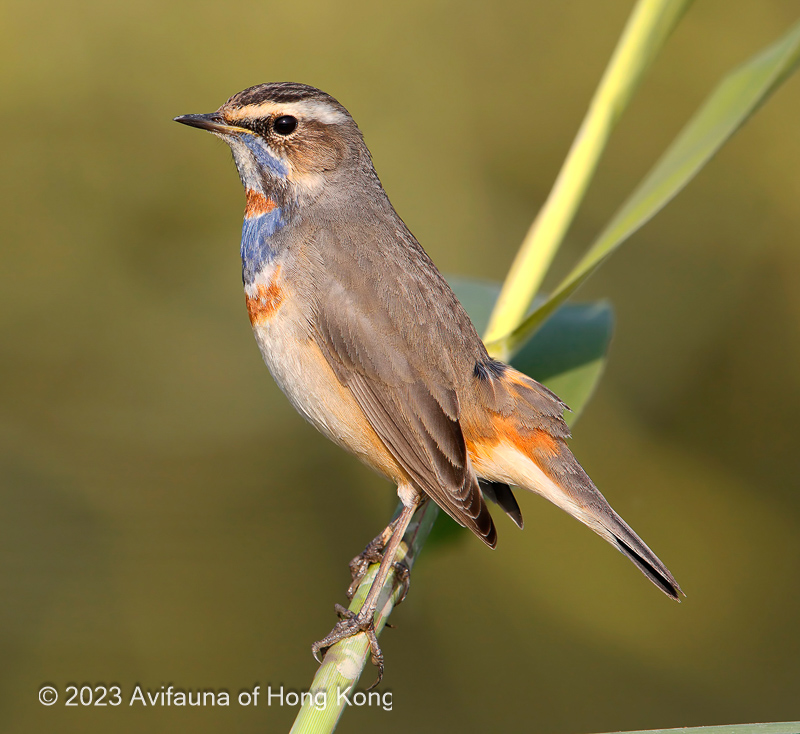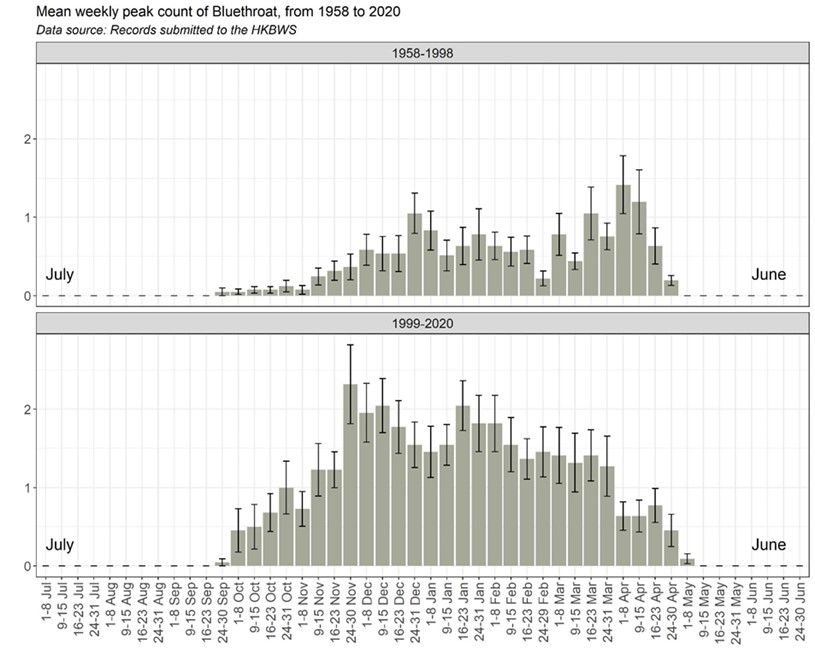Bluethroat Luscinia svecica 藍喉歌鴝
Category I. Uncommon winter visitor and much-declined spring passage migrant to vegetated wetlands in the northwest New Territories.
IDENTIFICATION

Dec. 2013, Martin Hale.
13-14 cm. All birds have grey-brown upperparts, rufous base of tail, which can be seen as it flies away, obvious whitish supercilium and relatively long and thin legs. The tail is often raised quickly and lowered slowly as it forages.
The patterned blue, black, white and red underparts of male are distinctive. L.s. svecica has a red throat patch. Duller in winter.

Dec. 2012, Michelle and Peter Wong.
This first-winter female lacks warm coloration except at base of tail and has a dark breast band and malar stripe.
Throat pattern of adult variable. Often has some blue at sides of throat, while older females may show a reduced amount of blue on the breast. Some first-winter males may be bluer on the breast.
VOCALISATIONS
The call most often heard is from birds that are usually hidden in vegetation: an explosive, slightly inflected, slightly rolling ‘keert’.
Otherwise, a high-pitched ‘see’ or richer and lower-pitched ‘chee’ followed by a dry, flat ‘trt’ or ‘chirt’ similar to tongue-clicking.
Song is rarely heard in HK and is usually not as fully developed as in this recording.
DISTRIBUTION & HABITAT PREFERENCE
Wetland-dependent species occurring in wet agriculture, reed marsh and vegetated watercourses, almost exclusively in the northwest New Territories. Most records are from Mai Po, San Tin, Lok Ma Chau and Long Valley.
OCCURRENCE
Uncommon winter visitor, with extreme dates of 27 September and 6 May. Rare in October, it is generally scarce at favoured sites until the final week of November, when the highest mean weekly peak count occurs (Figure 1), and early December, perhaps indicative of passage. Numbers remain similar from the third week of December until the end of March, but it becomes noticeably scarcer in April. Significant gaps between sightings at well-watched sites indicate that some (but not all) of the April records, particularly in the last two weeks of the month, are of passage migrants.
This pattern of occurrence differs from that during 1958-98, when there was no obvious late November peak. In addition, as Figure 1 indicates, there used to be a more obvious peak in spring. This decline in April passage was remarked upon by Welch et al. (2016) who speculated it was due to a regional decline in numbers, though it could also reflect the influence of milder winters that allow birds to winter further north.
Increases in numbers were noted in the mid-1980s and the 1990s due to coverage of wetland areas at Ha Tsuen (long-since filled in for container storage), and Long Valley, respectively. The maximum count was of 13 birds at the Long Valley on 28 January 1994. Annual numbers recorded since 1999 have shown a general increase since 2014/15 (Figure 2), peaking at an estimated minimum of 28 individuals in 2017/18. However, this is considered due to increased observer activity as peak single-site counts from 1990/91 to 2019/20 (Figure 3) have actually declined since the 1990s. Peak counts this century have not exceeded five.
Ringing data from Mai Po indicates that birds may remain in the same area for several weeks, e.g., one first trapped on 14 December 2015 was retrapped three times to the last recapture on 15 April 2016. Ringing data has also established site-fidelity: a first-calendar-year male originally ringed at Mai Po on 24 November 1991 was retrapped in the springs of 1992, 1993 and 1995, while a first-calendar-year female ringed at Mai Po on 12 December 2004 was retrapped there on 25 April 2008.
In addition, two Bluethroats ringed in Mai Po have been discovered on the Hebei coast in China. An adult male that trapped at Mai Po on 9 March 1986 was later seen in a cage near Qinhuangdao on 4 May 1990, and a first-year female ringed at Mai Po on 13 April 2018 was found during an operation against illegal bird trapping at Tangshan on 10 May 2019.
Vaughan and Jones (1913) regarded Bluethroat as a winter visitor to Guangdong and Guangxi. A female shot near Mai Po on 15 January 1936 (Herklots 1936) was the first record in HK. Subsequently, Herklots (1953), Dove and Goodhart (1955) and Herklots (1967) all regarded it as a winter visitor.
BEHAVIOUR, FORAGING & DIET
Mainly solitary, usually shy and keeps hidden in vegetation. When flushed it flies directly away, keeping low; when it lands it often fans its tail quickly, revealing the red patches at the base, before disappearing into vegetation.
Forages on the ground for insects, often concealed in low vegetation, but occasionally feeds out in the open.
RANGE & SYSTEMATICS
Bluethroat breeds across the Palearctic from Europe east through Russia to Siberia and south to Turkey, Iran, Kazakhstan, Transcaspia, the central Asian mountains, Afghanistan, the northern Himalayas, Mongolia, and western, central and northeast China. It winters south to southern Europe, northern and central Africa, southwest and southeast Asia, east to eastern China (Guzy et al. 2020).
A polytypic species, the nominate taxon breeds from Scandinavia east through Russia to northwest and northeast China (northwest Inner Mongolia and Heilongjiang) and Alaska, and winters in southern Europe, northern Africa, Arabia and south and east Asia, including HK. In China it is known to winter in Guangdong and Fujian (Liu and Chen 2020).
L. s. kobdensis breeds in southeast Siberia, western Mongolia and northwest China east to Tarim Basin, and winters in south and southeast Asia. L. s. przevalskii breeds in central China (central and east Qinghai to Nan Shan and east to Ala Shan and the Ordos Plateau), and winters in southwest China.
CONSERVATION STATUS
IUCN: Least Concern. Population trend stable.
Figure 1.

Figure 2.

Dove, R. S. and J. H. Goodhart (1955). Field observations from the Colony of HK. Ibis 97: 311-340.
Guzy, M. J., B. J. McCaffery, and N. Collar (2020). Bluethroat (Luscinia svecica), version 1.0. In Birds of the World (S. M. Billerman, Editor). Cornell Lab of Ornithology, Ithaca, NY, USA. https://doi.org/10.2173/bow.blueth.01
Herklots, G. A. C. (1936). Notes and comments. Ornithology. HK Naturalist 7: 81-86.
Herklots, G. A. C. (1953). HK Birds. South China Morning Post, HK.
Herklots, G. A. C. (1967). HK Birds (2nd ed.). South China Morning Post, HK.
Liu, Y. and Y. H. Chen (2020). The CNG Field Guide to the Birds of China (in Chinese). Hunan Science and Technology Publication House.
Vaughan, R. E. and K. H. Jones (1913). The birds of HK, Macao and the West River or Si Kiang in South-East China, with special reference to their nidification and seasonal movements. Ibis 1913: 17-76, 163-201, 351-384.
Welch, G., J. Allcock and R. Lewthwaite (2016). Decline in some HK land bird species: 1990-2014. HK Bird Report 2014: 340 – 358.

